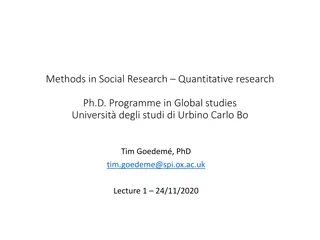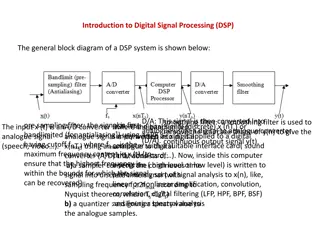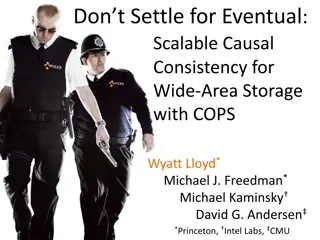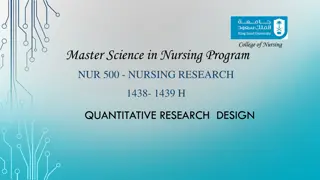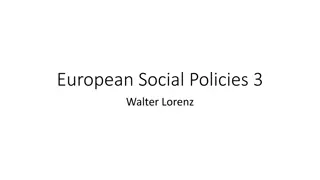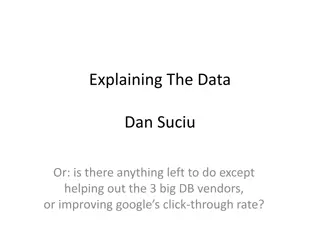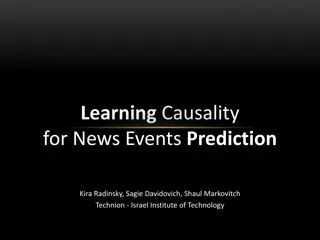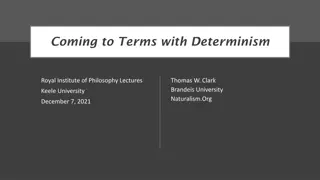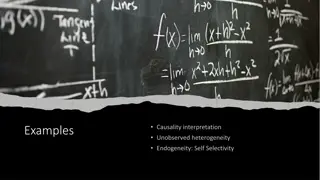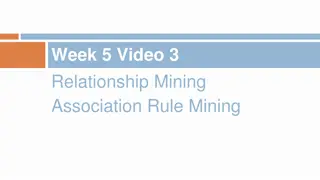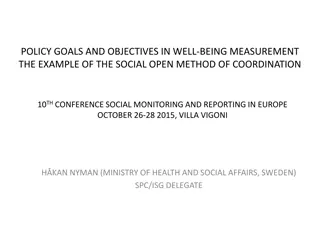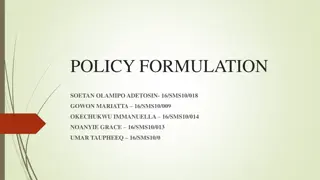Understanding Causality in Social Policy: A Comprehensive Overview
This content delves into the concept of causality in social policy, focusing on different types of causal relationships and frameworks for causal analysis. It explores the importance of understanding causality for evidence-based policy making and evaluation, touching on key questions and relevant background texts.
Download Presentation

Please find below an Image/Link to download the presentation.
The content on the website is provided AS IS for your information and personal use only. It may not be sold, licensed, or shared on other websites without obtaining consent from the author. Download presentation by click this link. If you encounter any issues during the download, it is possible that the publisher has removed the file from their server.
E N D
Presentation Transcript
Maatschappij, Beleid en Evaluatie Tim Goedem tim.goedeme@uantwerpen.be Les 7 10/11/2015
Q&A course so far, brief evaluation Interim evaluation of course Three types of texts: Texts to study: slides help to understand texts Texts to read: texts help to understand slides Background texts: most relevant texts with additional material on which I have drawn Questions and answers
Lecture 7 Causality and public policy 1. Types of causal relationships 2. Frameworks for thinking about causality 3. The Neymar-Rubin-Holland approach 4. Questions for causal analysis
Main questions this lecture What is causality? What type of causality should be of interest to policy makers? Are randomised controlled trials the ideal for evidence-based policy? Are they sufficient? Why (not)? Please explain
Background texts Brady, H. E. (2008), 'Causation and explanation in social science', in Box-Steffensmeier, J. M., Brady, H. E. and Collier, D. (eds.), The Oxford Handbook of Political Methodology, Oxford: Oxford University Press, pp. 217-270. [compulsory] Angrist, J. D., and Pischke, J.-S. (2009), Mostly Harmless Econometrics, Princeton: Princeton University Press, 373p. Chapter 1 & 2 [background] Holland, P. W. (1986), 'Statistics and Causal Inference' in Journal of the American Statistical Association, 81(396): 945-960 [background]
Introduction For monitoring the social situation and policies, we use indicators However, when designing or evaluating policies, we need more We want to know how we can change things through manipulating policy parameters And we want to understand the current situation, and in particular how policies and changes in policies have contributed to the current (or past) situation For evidence-based policy and policy evaluation, we need additional tools: theories & methods that help us understand causes and effects
Types of causal relationships Direct effect Indirect effect Common cause (spurious correlation)
Types of causal relationships Bidirectional causation (e.g. self-reinforcing processes) (and endogeneity) (Insufficient but) necessary condition of cause
Types of causal relationships (Unnecessary but) exclusively sufficient cause Others: Interacting causes Coincidence (pure correlation, so no causality)
Types of causal relationships Endogenous vs. exogenous causes / variables (Picture: wikipedia)
Types of causal relationships Formal ways to present causal relationships in e.g.: Bayesian network (& Directed acyclic graphs, DAGs) Path diagrams in path analysis
Characteristics of causal relationships Identification of symmetry of causal relationship Identification of asymmetry of causal relationship Deterministic causation (e.g. switch on light) vs. probabilistic causation (e.g. work and poverty)
Learning from philosophy Causality: 3 questions (Brady, 2008) Psychological: what do we mean by causality when we use the concept Ontological: What is causality Epistemological: how do we discover when causality is operative?
4 approaches (Brady, 2008) Humean and Neo-Humean approach Counterfactual approach Manipulation approach Mechanism approach
4 Approaches Approaches differ with respect to: Emphasis on causes of effects or effects of causes Approach to identifying symmetric aspect of causality Approach to identifying asymmetric aspect of causality Major problems solved
Humean & neo-humean approach The simple approach: Two events are causally related if: They are contiguous in space and time One precedes the other David Hume 1711 1776 , UK (Wikipedia) They occur regularly in constant conjunction with one another
Humean & neo-humean approach => Focus is on identifying logical conditions that must hold Classic definition of causality: X is a cause of Y if and only if X is sufficient for Y But many causes are not sufficient: E.g. working and not being poor, striking a match
Humean & neo-humean approach X is a cause of Y if and only if X is necessary for Y But many effects may have multiple sufficient causes: E.g. feeling sick (virus, bacteria, car sick, ) And some necessary conditions are not always considered a cause E.g. there must be men and women before someone can get pregnant
Humean & neo-humean approach John Mackie: the INUS conditions: A cause is Insufficient, but a [I] Necessary part of a condition, [N] which is itself Unnecessary, [U] but exclusively Sufficient [S]
Humean & neo-humean approach In other words: A putative cause is not always the cause if other factors may cause the same phenomenon to happen (multiplicity of causal pathways) Interactions among causes may be necessary for any one cause to be sufficient (conjunctural causation) Relationship between any INUS cause and its effect might appear to be probabilistic because of the other INUS causes => social science relationships will appear probabilistic even if they are deterministic
Humean & neo-humean approach But INUS conditions are no perfect definition of causal relationships: Situations where there are common causes (third variable affecting both A and B, but also the effect + indirect effects) Accidental regularities Based on correlations: impossible to assess whether effect is cause or cause is effect, except for temporal precedence
Humean & neo-humean approach Symmetric aspect of causality: observation of constant conjunction and correlation Asymmetric aspect: temporal precedence Major problems solved: necessary condition Emphasis: causes of effects
Counterfactual approach If, in the most similar world, X would not have occurred, would Y then still have occurred? => counterfactual David Kellogg Lewis 1941-2001, US (Univ of Melbourne)
Counterfactual approach X causes Y if (assuming X and Y have occurred): If X were to occur, then Y would occur; and If X were not to occur, then Y would not occur either
Counterfactual approach Causal assessment of singular events is possible (not general laws as in neo-Humean approach) But how to evaluate the second counterfactual if it never took place? Identify the closest possible world and assess what would happen (e.g. world without social policies?) Only possible if one knows the lawlike regularities that govern our world (cf. Humean approach) (cf. deficiencies of pre-post approach)
Counterfactual approach Benefits of the approach: No need to observe universal conjunction of cause and effect Provides way to think about causality of singular events
Counterfactual approach Problems: Direction of causation cannot be established When is a surrogate world close enough to function as an adequate counterfactual? Common causal factor of putative cause and effect (i.e. spurious correlation ) > Assess whether if Y did not occur, then X would not occur is false?
Counterfactual approach Causal pre-emption: when two causes have the same effect, and one cause excludes the other
Counterfactual approach Symmetric aspect: truth in otherwise similar world of if the cause occurs, then so does the effect and if the cause does not occur, then the effect does not occur Asymmetric aspect: if the effect does not occur, then the cause may still occur Major problems solved: singular causation, nature of necessity Emphasis: Effects of causes & causes of effects
Manipulation approach Rather than imagining a counterfactual, create a counterfactual through manipulation of the putative cause (Quasi-)Experiment: manipulate one and only one factor, keep all else constant If Y occurs when X is not, and Y occurs when X occurs, than X is cause of Y, because X is only difference between the two situations => Manipulation allows for establishing the direction of the relationship
Manipulation approach In contrast to philosophers, methodologists and practitioners blend counterfactual and manipulation approach for better understanding of causality Closest possible worlds (rule out accidental correlation) & manipulation (identify direction of causality)
Manipulation approach Symmetric aspect: recipe that regularly produces the effect from cause Asymmetric aspect: observation of the effect of the manipulation Major problems solved: common cause and causal direction Emphasis: effects of causes
The mechanism approach Experiments / counterfactual approach do badly with regard to: Causal pre-emption (when one cause acts just before and pre-empts another) Cannot readily explain the causes of effects (in contrast to the effects of specific causes) Phenomena (causal factors) that cannot be easily manipulated or isolated
The mechanism approach Two events are causally connected if and only if there is a mechanism connecting them => there is a need to understand the mechanisms at work Mechanisms are entities and activities organised such that they are productive of regular changes from start or setup to finish or termination conditions (Machamber et al., 2000: 3 in Brady, 2008) => break causal mechanisms down into their different parts and study those in various contexts
The mechanism approach Symmetric aspect: is there a mechanism or capacity that leads from cause to effect? Asymmetric aspect: appeal to operation of mechanism Major problems solved: causal pre-emption Emphasis: Causes of effects
Summing up Identification of causality is strongest if: Constant conjunction of causes and effects (Neo-Humean) No effect when the cause is absent in the most similar world (counterfactual) An effect after a cause is manipulated (manipulation) Identification of activities and processes linking causes and effects (mechanism)
Neyman-Rubin-Holland: a golden standard? Ronald Fisher Jerzy Neyman Donald Rubin Paul Holland (pictures: wikipedia / Psychometric society)
Neyman-Rubin-Holland No causation without manipulation (attributes such as race and gender are no causes) A cause is always relative to another cause (A vs. not A) Fundamental problem of causal inference: it is impossible to observe the effect of a cause on the same case (either one is subject to the cause, or one is not)
Neyman-Rubin-Holland Solutions (assumptions): Temporal stability (one can measure effect on same case by manipulating consecutively) and causal transience (effect does not change after one manipulation or the other) => usually not applicable to humans or institutions Unit homogeneity or invariance: identicality of units and treatment (assume all units have the same (conditional) properties and reaction to cause) => usually not applicable to humans or institutions
Neyman-Rubin-Holland Solutions (assumptions): Independence assumption: if treatment is assigned randomly, then difference in outcome between treated and non-treated equals expected average causal effect Constant effect: effect on each unit is equal to average causal effect Stable-Unit-Treatment Value Assumption (SUTVA): non- interference of units (treatment of one unit does not affect outcome of other unit) (micro-meso-macro level)
Neyman-Rubin-Holland When independence and SUTVA assumptions hold, randomised experiments are a powerful tool! (equations from Angrist and Pischke)
Neyman-Rubin-Holland Observed outcome Y for individual i: With Y1i Y0ithe causal effect for individual i
Neyman-Rubin-Holland Average causal effect:
Neyman-Rubin-Holland With random assignment of Di, Di is independent of potential outcomes:
Neyman-Rubin-Holland Random assignment solves problem of selection bias! If your study does not include random assignment, selection bias is probably a very important challenge for causal statements.
Neyman-Rubin-Holland: a golden standard? Limitations of experiments: Average causal effect: assumption of constant effect is not realistic, variance may be substantial Causal pre-emption Pairing (identifying exact causes in singular events) Assumption of SUTVA (stable-unit-treatment value assumption
Neyman-Rubin-Holland: a golden standard? Problems with SUTVA (Brady, 2008: 265): Compensatory rivalry Resentful demoralization Compensatory equalisation Treatment diffusion But also: macro level effects (e.g. general equilibrium, reduced value of education, poverty line effect, )
Neyman-Rubin-Holland: a golden standard? Limitations of experiments: Average causal effect Causal pre-emption Pairing (identifying exact causes in singular events) SUTVA (through micro, meso- or macro-level interactions) Limits to external validity (repetition, population, other policies, upscaling) Only possible for effects of causes, not causes of effects
Neyman-Rubin-Holland: a golden standard? Evidence-based policy requires more than random experiments (and equivalents): Descriptive studies Comparative studies Decompositions Model-based studies (e.g. microsimulations) But one should be clear about limits to causal inference and external validity!
Causal analysis: crucial questions 1. What is the causal relationship of interest? What are its characteristics, and what would you like to infer from it? 2. What is the research setup (experiment) that could ideally be used to capture the causal effect of interest? 3. What is your identification strategy? 4. What is your mode of statistical inference? 5. To what extent are results generalizable (to broader population, other fields of interest/policy areas; upscaling)? 6. What lessons for policy makers do you wish to draw?






